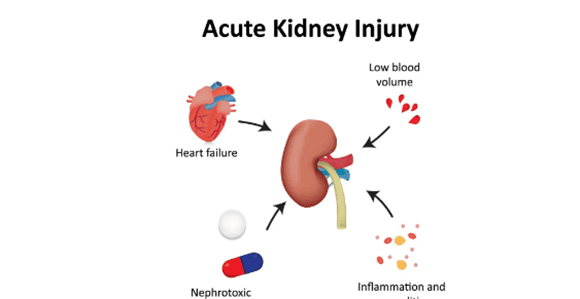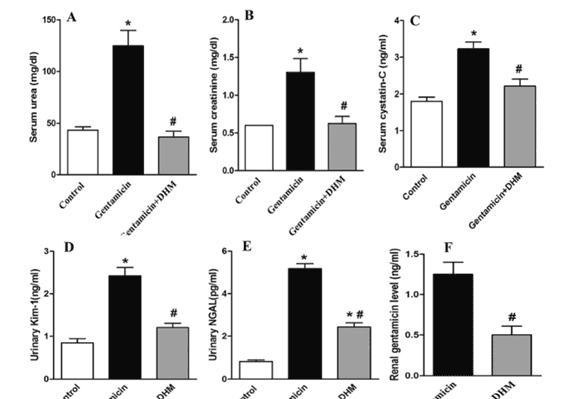Gentamicin (GTN) is an effective bactericidal agent against serious infections caused by Gram-negative bacteria. It is also used to prevent bacterial infections after surgical procedures.
Unlike some traditional antibiotics, gentamicin has the advantage of low incidence of resistance and low cost.
However, nephrotoxicity is the main complication that limits the widespread use of gentamicin.

Gentamicin, is The main factors leading to acute kidney injury (AKI). Acute kidney injury affects 20 million to 200 million people worldwide and may lead to approximately 2 million deaths each year.
Gentamicin-induced acute kidney injury is time- and dose-dependent; nearly 30% of patients develop acute tubular injury within 5 to 7 days after gentamicin administration. Extending the duration of gentamicin administration to 14 days may double the risk of nephrotoxicity. Sometimes, acute kidney injury caused by gentamicin may progress to chronic kidney disease.
Many therapeutic drugs can be used with gentamicin to prevent its nephrotoxicity. The flavonoids rutin and quercetin are natural compounds with antioxidant and anti-inflammatory effects that can antagonize gentamicin-induced kidney damage.
Currently, the pharmaceutical community is becoming more and more interested in the pharmacological activities of D-flavonoids, which are flavonols extracted from the Chinese plant Vitis vinifera. D-flavonoids have been traditionally used as a treatment for the common cold, fungal infections, sore throats, hepatitis and fever. Today, it is used to treat alcoholism and as a nutritional supplement for the liver.
Multiple studies have shown that D-flavonoids have effective antioxidant and anti-inflammatory effects, so it can improve different conditions, including: hyperlipidemia, hypertension, hyperglycemia, and impaired cognitive function , cancer, and gentamicin-induced ototoxicity.
Notably, D-flavonoids have been found to have nephroprotective effects on acute and chronic kidney changes. It can prevent and alleviate diabetic nephropathy, prevent the development of chronic kidney disease by blocking vascular calcification, and prevent acute kidney injury caused by lipopolysaccharide and sepsis.
On November 29, 2023, the journal "Life Science" published a study "D-flavonoids prevent gentamicin-induced nephrotoxicity by up-regulating renal SIRT3 and PAX2" from the School of Pharmacy of Miniya University in Egypt.
The study found that D flavonoid treatment improved the deterioration of renal function caused by gentamicin; serum urea, creatinine and cystatin-C levels, as well as sensitive indicators of early renal damage in urine, Kim-1 and NGAL levels decreased.
In addition, D-flavonoids eliminated the gentamicin-induced changes in kidney morphology. These renal protective effects may be mediated by reducing renal gentamicin accumulation, activating antioxidant enzymes GSH, SOD and CAT, and reducing lipid peroxidation and nitric oxide levels.
D flavonoids also inhibit renal inflammation and apoptosis by reducing the expression of NF-κB, TNF-α and caspase-3. These effects were associated with upregulation of renal SIRT3 expression. In addition, D-flavonoids activate the regeneration and replacement of damaged renal tubular cells by enhancing PAX2 expression.
D flavonoids can weaken the accumulation of gentamicin in renal tissue and improve renal function
Animal experiments have found that gentamicin can cause renal dysfunction and glomerular filtration Damage is manifested by increases in serum urea, creatinine, cystatin-C, urinary Kim-1, and NGAL, as well as the accumulation of gentamicin in renal tissue.
D flavonoid treatment can improve renal function, which is manifested by the reduction of the above indicators and the reduction of gentamicin in renal tissue.
D flavonoids can prevent gentamicin-induced renal histological changes
Gentamicin-induced nephrotoxicity can be observed in renal cortical tissue abnormalities through H&E sections. The gentamicin group showed changes such as lobular structural disorder, glomerular atrophy, Bowman's capsule expansion, tubule dilation, tubule inner wall apoptosis, and inflammatory cell infiltration.
However, D flavonoid treatment eliminated these histopathological changes; compared with the gentamicin group, the renal tubular cells in the D flavonoid group had less vesicular nuclei, less inflammation, and less apoptosis. The renal histopathological change score also showed that D-flavonoid treatment significantly improved the degenerative signs caused by gentamicin.
D flavonoids reduce the increase in renal oxidative stress caused by gentamicin
Gentamicin treatment can lead to an increase in renal oxidative stress, which is manifested in oxidative indicators such as renal MDA and NO. increase, and decrease in antioxidant indicators such as SOD, CAT, GSH and GSH/GSSG.
However, D flavonoid treatment can inhibit the increase in renal oxidative stress, which is manifested by the decrease in oxidative indicators such as renal MDA and NO, and the increase in antioxidant indicators such as SOD, CAT, GSH and GSH/GSSG.
D flavonoids improve renal tubular inflammation caused by gentamicin
Gentamicin treatment can lead to the expression of NF-κB in glomeruli, proximal convoluted tubules and distal convoluted tubules. Expression is upregulated, NF-κB is a transcription factor involved in the production of inflammatory cytokines. As a result, kidney levels of TNF-α, an inflammatory cytokine, were significantly elevated.
However, D flavonoid treatment showed an anti-inflammatory effect, which was manifested as a significant decrease in renal NF-κB and TNF-α levels.
D flavonoids down-regulate the expression of apoptosis marker caspase-3 in renal tissue, while up-regulating the expression of SIRT3
Gentamicin treatment can cause glomerular and proximal tubule Strong expression of caspase-3, a marker of apoptosis, indicating increased apoptosis.

But D flavonoids treatment can inhibit Kidney cell apoptosis is manifested by reduced expression of caspase-3 and promotion of the expression of kidney longevity protein SIRT3. SIRT3 is a mitochondrial deacetylase that regulates oxidative stress, inflammation and cell death.
There may be a parallel relationship between D-flavonoid-mediated upregulation of SIRT3 expression and reduction of apoptosis, inflammation and oxidative stress.
D flavonoid increases renal PAX2 expression and promotes recovery of gentamicin-induced renal injury
Compared with the gentamicin group, D flavonoid showed a significant increase in PAX2 levels, PAX2 is a transcription factor encoding renal cell regeneration. This suggests that D-flavonoids activate the regeneration and replacement of damaged renal tubular cells by enhancing PAX2 expression.
Conclusion
This study elucidates for the first time the role of D-flavonoids as a promising therapeutic agent against the nephrotoxic effects of gentamicin. D-flavonoids exert antioxidant, anti-inflammatory and anti-apoptotic effects by stimulating the expression of SIRT3 and PAX2 in the kidney, and improve renal tubular cell regeneration, ultimately maximizing renal recovery.

 扫一扫微信交流
扫一扫微信交流
发布评论